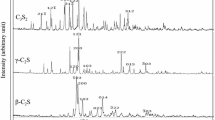Abstract
The phase transformation in calcification process was investigated by X-ray diffraction (XRD) and differential scanning calorimeter (DSC), and the effect of calcification on the leaching rate of rare earth was analyzed. The results show that bastnaesite transforms into rare earth hydrate at the calcification temperature range of 225–300 °C. However, this transition is verified to be an efficient reaction for the activating bastnaesite when the temperature is higher than 200 °C. The leaching rate of rare earth increases to 89.17 % for activating bastnaesite from 36.27 % for the bastnaesite, and it is the highest with calcification temperature of 250 °C, which is consistent with the result of DSC analysis. The transition of rare earth oxyfluoride into RE(OH)3 is accelerated by the addition of NaOH according to the experiments of different calcification systems.
Graphical Abstract
In the calcification process, the diffraction peak corresponding to RE(OH)3 appears and the diffraction peak corresponding to REOF disappears for activated ores. However, for bastnaesite, there is no apparent phase transition at the temperature of 270 °C, except that the weak diffraction peak corresponding to RE(OH)3 appears









Similar content being viewed by others
References
Xu GX. Rare Earth. 2nd ed. Beijing: Metallurgical Industry Press; 1995. 125.
Özbayoğlu G, Atalay MÜ. Beneficiation of bastnaesite by a multi-gravity separator. J Alloys Compd. 2000;303:520.
Kanazawa Y, Kamitani M. Rare earth minerals and resources in the world. J Alloys Compd. 2006;408:1339.
Chen ZH. Global rare earth resources and scenarios of future rare earth industry. J Rare Earths. 2011;29(1):1.
Kul M, Topkaya Y, Karakaya I. Rare earth double sulfates from pre-concentrated bastnesite. Hydrometallurgy. 2008;93:129.
Yorukoglu A, Obut A, Girgin I. Effect of thiourea on sulphuric acid leaching of bastnaesite. Hydrometallurgy. 2003;68(1):195.
Bian X, Yin SH, Luo Y, Wu WY. Leaching kinetics of bastnaesite concentrate in HCl solution. Trans Nonferrous Metals Soc China. 2011;21(10):2306.
Wu ZY, Sun SC, Wu WY, Bian X, Tu GF. Effect of RH on fluorine escaping course during roasting of bastnaesite. Chin Rare Earths. 2008;29(5):1.
Sun SC, Gao B, Wu ZY, Bian X, Wu WY, Tu GF. Effect of CaO on fluorine in gas phase during decomposition of mixed rare earth concentrate. Chin J Rare Met. 2007;31(3):400.
Li DD, Long ZQ, Li HW, Zhang GC. Leaching behaviors of Ce4+ and Fe3+ ions in bastnaesite with sulfuric acid. Chin J Rare Met. 2004;28(2):452.
Fu HY, Wei YY, Li Y, He JG. Separation of fluoride/cerium by aluminum salt coordination from bastnasite sulfuric acid leaching solution. J Chin Rare Earth Soc. 2013;31(4):393.
Wang MH, Zeng M, Wang LS, Zhou JH, Cui DL, Wang QQ, Wong RG, Chen XS. Catalytic leaching process of bastnaesite with hydrochloric acid after oxidation roasting pretreatment. J Chin Soc Rare Earths. 2013;31(2):148.
Zhang SR, Tu GF, Ren CZ, Zhang CX, Li CC. Study on the decomposition behavior of bastnasite. Chin J Rare Met. 1998;22(3):185.
Liu SG, Wei XJ. Study on the roast reaction of bastnasite. Chin J Rare Earths. 1997;18(2):15.
Liu H, Ao B, Tao M, Luo Q. Development status and research process in rare earth hydrometallurgy for Sichuan bastnasite. Chin Nonferrous Metall. 2009;1(2):33.
Wu ZY, Wu WY, Sun SC, Bian X, Tu GF. Inhibition of fluorine escape in calcinations process of rare earth concentrate. Chin J Rare Met. 2010;34(2):276.
Zhang QW, Saito F. Non-thermal process for extracting rare earths from bastnaesite by means of mechanochemical treatment. Hydrometallurgy. 1998;47(2):231.
Tu GF, Ren CZ, Xing PF, Li CC, Zhang CX. The roasted reaction of bastnaesite concentrate. Non-Ferr Min Metall. 1999;15(6):18.
Huang YK, Zhang TA, Dou ZH, Liu J, Tang FF. Activating decomposition of bastnaesite concentrate to extracting rare earth with calcification transition process. J Rare Earths. 2014;32(6):719.
Huang YK, Zhang TA, Dou ZH, Liu J, Tang FF. Study on leaching rare earths from bastnaesite treated by calcification transition. J Rare Earths. 2014;32(11):1043.
Acknowledgments
This study was financially supported by the National Basic Research Program of China (No. 2012CBA01205).
Author information
Authors and Affiliations
Corresponding author
Rights and permissions
About this article
Cite this article
Huang, YK., Zhang, TA., Dou, ZH. et al. Phase transition of bastnaesite concentrate in calcification process. Rare Met. 35, 649–654 (2016). https://doi.org/10.1007/s12598-016-0756-x
Received:
Revised:
Accepted:
Published:
Issue Date:
DOI: https://doi.org/10.1007/s12598-016-0756-x




